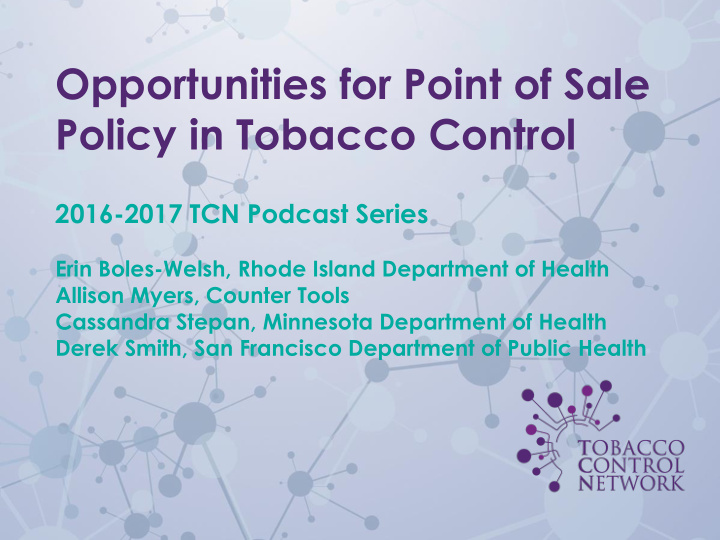



Opportunities for Point of Sale Policy in Tobacco Control 2016-2017 TCN Podcast Series Erin Boles-Welsh, Rhode Island Department of Health Allison Myers, Counter Tools Cassandra Stepan, Minnesota Department of Health Derek Smith, San Francisco Department of Public Health
The Community Action Model (CAM): A San Francisco Public Health Tradition
2004- Tobacco Retailer License established Requires all tobacco retailers to 30 28 obtain a local license 25 25 Sales rate (% of stores) Requires them to abide by all 22 20 laws regarding tobacco sales 18 19 20 17 16 15 Allows the City to suspend 15 12 13 13 licenses when sales laws are broken 10 Has resulted in a drop of illegal 5 youth sales from 28% in 2003 to 0 13% in 2012
2010- Healthy Retail San Francisco ordinance kicks off the building of a supportive program After research showing food desserts, tobacco and food advocates encouraged a program to help create healthy stores Corner stores receive small business development assistance to partially convert to healthy retail Department of Public Health and community advocates engage stores to keep them involved, tell their story, and encourage neighbors to check out the relaunched stores
2015- Retailer density ordinance adopted Social justice effort to reduce overconcentration of retailers in neighborhoods Sets a future cap of 45 stores per neighborhood- attrition to lead to equity by district Those districts over the cap cannot issue new TRL permits (two districts started at 400% of the cap) In the first 18 months of operation, we saw a 9% attrition of the total number of places where one could purchase tobacco- these stores are now retired
FUTURE POTENTIAL APPROACHES: Menthol and e-cig flavors • Minimum pack size (avoiding • cheap cigarillos/blunts) Minimum pricing • Healthy Retail program • expansion to more stores/communities Derek Smith, MPH, MSW San Francisco Department of Public Health derek.smith@sfdph.org SFtobaccofree.org
tcn@astho.org THANK YOU! 7
Recommend
More recommend